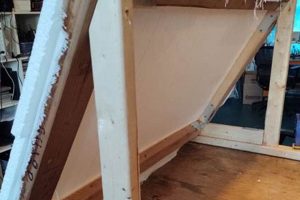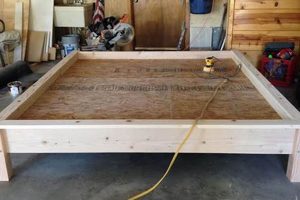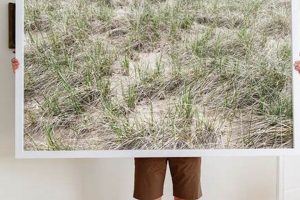Creating personalized enclosures for instant film photographs through do-it-yourself methods enhances the presentation and preservation of these unique images. Such projects often involve readily available materials and basic crafting techniques to construct housings specifically tailored to the dimensions of instant film prints, adding a distinct aesthetic element. For example, individuals might utilize cardboard, wood, or repurposed items to fashion a border or structure that complements the photograph’s subject matter or the room’s decor.
The value in crafting bespoke surrounds for instant images lies in the ability to elevate the visual impact and provide a protective barrier against environmental factors like dust and fingerprints. Historically, photographs have always been displayed with care, and the current trend of creating custom housings allows individuals to continue this tradition with a contemporary, hands-on approach. This practice also offers a cost-effective and environmentally conscious way to showcase valued memories.
The following sections will explore various methods and material choices for constructing these customized displays, detailing specific techniques to achieve diverse aesthetic results and ensure long-term preservation of the enclosed instant photographs. This will include discussions on material selection, construction techniques, and design considerations.
Construction Advice for Bespoke Instant Film Housings
The following guidelines are intended to assist in the creation of personalized enclosures for instant film photographs. Adherence to these suggestions can improve the aesthetic and protective qualities of the finished product.
Tip 1: Material Selection: Opt for acid-free materials when constructing a housing. Acidic components within cardboard or paper can degrade the photograph over time, leading to discoloration and image deterioration. Consider using archival-quality mat board or pH-neutral adhesives.
Tip 2: Precision Measurement: Accurately measure the dimensions of the instant film print before commencing construction. Allow for a slight tolerance to prevent the photograph from being tightly compressed, which can cause damage. Precise measurements are crucial for a professional aesthetic.
Tip 3: Edge Protection: Incorporate a recessed border or lip to protect the edges of the photograph from physical damage. This feature prevents accidental bending or creasing during handling and display. Consider a rabbet joint for a clean, secure fit.
Tip 4: Adhesive Application: Employ archival-quality, photo-safe adhesives sparingly. Overapplication can lead to adhesive bleed or chemical interactions with the photograph. Test the adhesive on a scrap piece of material before applying it to the final project.
Tip 5: Surface Finishing: Apply a protective sealant or varnish to the exterior surfaces of the housing to prevent moisture absorption and enhance durability. Ensure the chosen finish is non-reactive and will not off-gas harmful chemicals.
Tip 6: Glazing Considerations: If incorporating a transparent cover, opt for UV-resistant acrylic or glass to mitigate fading caused by sunlight exposure. Standard glass offers minimal UV protection, potentially shortening the lifespan of the displayed photograph.
Tip 7: Ventilation: Consider incorporating small ventilation holes in the back of the housing to allow for air circulation and prevent moisture buildup. Trapped moisture can promote mold growth and accelerate image degradation.
By implementing these guidelines, individuals can create durable, aesthetically pleasing housings that safeguard their instant film photographs from environmental damage and enhance their long-term preservation. Prioritizing material quality and construction precision is paramount to achieving a professional result.
The subsequent sections will delve into specific design considerations and advanced techniques for constructing more elaborate and personalized displays, building upon the foundational principles outlined above.
1. Material Longevity
The selection of materials with inherent durability and resistance to degradation is paramount in the creation of long-lasting housings for instant film photographs. The longevity of the chosen material directly influences the preservation of the encased image. Inferior materials, such as those containing acidic compounds, can cause chemical reactions that degrade the photograph over time, resulting in discoloration, fading, and eventual image loss. Conversely, archival-quality materials, engineered to resist these degradation processes, extend the lifespan of both the housing and the enclosed photograph. For instance, using lignin-free matboard, which is chemically stable and acid-free, prevents the leaching of harmful acids into the photograph, thereby protecting it from premature deterioration. This is a critical consideration in any do-it-yourself project intended to showcase and preserve valuable instant film prints.
Practical applications of this understanding extend to the careful selection of adhesives and coatings as well. Acidic adhesives, for example, can permeate the photograph’s emulsion, leading to irreversible damage. The use of pH-neutral, archival-grade adhesives mitigates this risk. Similarly, coatings applied to the exterior of the housing should be non-reactive and free from volatile organic compounds (VOCs), which can accelerate the breakdown of photographic materials. Consider the example of a housing constructed from untreated wood; the natural acids within the wood could potentially migrate to the photograph, leading to its deterioration. Therefore, a sealant or varnish that creates a barrier between the wood and the photograph is essential for long-term preservation.
In summary, material longevity is a critical determinant of the success of any project aimed at creating customized displays for instant film photographs. The use of archival-quality materials, combined with careful attention to adhesive and coating selection, ensures the long-term preservation of the enclosed image. Overlooking this aspect can lead to irreversible damage and the loss of valuable photographic memories. Challenges arise in sourcing authentic archival-grade materials and verifying their chemical composition; however, the investment in these materials is essential for those prioritizing the long-term integrity of their instant film prints.
2. Adhesive Stability
Adhesive stability is a critical factor in the construction of personalized displays for instant film photographs. The long-term preservation of these images relies heavily on the chemical inertness and durability of the adhesives used in housing construction. Instability in adhesives can lead to detrimental effects on the photograph, compromising its visual integrity and longevity.
- Chemical Inertness and Photo Degradation
Adhesives must exhibit chemical inertness to prevent reactions with the photograph’s emulsion. Acidic or volatile compounds within an adhesive can cause discoloration, fading, or even structural damage to the photograph over time. Archival-quality adhesives, which are pH-neutral and free of harmful solvents, are essential to mitigate these risks. The selection of appropriate adhesives directly impacts the long-term visual quality of the displayed instant film print.
- Adhesive Strength and Structural Integrity
The adhesive’s strength determines the structural integrity of the housing. Weak or deteriorating adhesives can lead to the delamination of components, compromising the housing’s protective function and potentially exposing the photograph to environmental damage. Durable adhesives, capable of maintaining their bond strength over time, are necessary to ensure the housing remains intact and continues to provide adequate protection.
- Application Techniques and Long-Term Performance
Proper application techniques are crucial for maximizing the adhesive’s long-term performance. Over-application can lead to adhesive bleed, potentially staining the photograph. Insufficient application may result in weak bonds that fail over time. Following manufacturer’s guidelines and employing appropriate application tools are essential for ensuring the adhesive functions as intended throughout the housing’s lifespan.
- Environmental Resistance and Adhesive Lifespan
The adhesive’s resistance to environmental factors, such as temperature fluctuations and humidity, impacts its overall lifespan. Adhesives that degrade under these conditions can lose their bond strength, leading to housing failure and photograph exposure. Selecting adhesives specifically formulated for environmental resistance is crucial, particularly in regions with extreme climates or fluctuating humidity levels.
In essence, the selection and application of stable adhesives are integral to the success of “polaroid picture frame diy” projects. The adhesive not only holds the structure together but also plays a direct role in preserving the enclosed instant photograph. Ignoring adhesive properties can lead to irreversible damage and a significant reduction in the photograph’s lifespan, thereby negating the effort invested in creating a personalized display. Careful consideration of adhesive characteristics ensures both the structural integrity and the long-term preservation of the photograph.
3. Dimensional Accuracy
Dimensional accuracy constitutes a foundational element within the realm of creating customized housings for instant film photographs. Deviations from precise measurements directly impact the functionality, aesthetic appeal, and protective capabilities of the finished enclosure. An undersized housing risks compressing the photograph, leading to potential damage to the emulsion layer or physical bending of the print. Conversely, an oversized housing may result in the photograph shifting within the enclosure, increasing the risk of abrasion, dust accumulation, and diminished visual presentation. The cause-and-effect relationship between accurate measurement and a well-executed housing is direct and significant. Without meticulous attention to dimensional precision, the intended benefits of a custom housingprotection and enhanced displayare compromised.
Practical examples demonstrate the importance of this principle. Consider a housing intended to display a standard-sized instant film print. If the interior dimensions of the housing are even slightly smaller than the photograph, forcing the print into the enclosure can cause edge damage, such as creasing or tearing. The cumulative effect of repeated attempts to insert or remove the photograph from an ill-fitting housing can result in significant and irreversible damage. Similarly, if the housing’s window or opening is not precisely aligned with the photograph’s image area, portions of the print may be obscured, detracting from the overall aesthetic presentation. Such misalignments undermine the intent of the custom housing, rendering it less effective as a means of showcasing the photograph.
In summary, dimensional accuracy is not merely a technical detail but a crucial prerequisite for successful personalized enclosures. It ensures the photograph is protected, properly displayed, and preserved for the long term. Challenges in achieving perfect dimensions may arise due to variations in material thickness or inherent inaccuracies in measuring tools. However, the effort expended in achieving dimensional precision is directly proportional to the quality and longevity of the final product. This principle underscores the importance of meticulous planning and execution within the broader context of crafting customized displays for instant film photographs.
4. Edge Protection
Edge protection, within the context of crafting customized enclosures for instant film photographs, is a fundamental design consideration. It directly influences the long-term preservation and aesthetic presentation of the enclosed photograph. The vulnerable edges of instant film prints are susceptible to damage from handling, environmental factors, and physical contact. Therefore, effective edge protection is paramount in mitigating these risks.
- Physical Damage Mitigation
Effective edge protection serves as a barrier against physical damage such as bending, creasing, and tearing. A recessed design, where the photograph is set slightly below the surface of the housing, or a lip that overlaps the edges, prevents direct contact with external forces. This is particularly relevant when the housing is handled frequently or transported. Failure to provide adequate physical protection can result in permanent damage to the photograph’s edges, diminishing its visual appeal and value.
- Environmental Barrier
The edges of instant film prints are also vulnerable to environmental factors like moisture and airborne contaminants. A well-designed edge protection system can minimize exposure to these elements. A sealed or tightly fitted enclosure prevents moisture from seeping into the photograph’s emulsion layer, which can cause warping or discoloration. Similarly, it reduces the accumulation of dust and particulate matter, which can scratch the surface or obscure the image over time. A secure edge seal contributes significantly to the long-term preservation of the photograph.
- Aesthetic Enhancement
Beyond its protective function, edge protection can also enhance the aesthetic appeal of the display. A clean, precisely executed edge detail provides a professional and polished look. The choice of materials and design elements for the edge can complement the photograph’s subject matter or the overall decor of the room. A well-considered edge treatment elevates the visual presentation, transforming a simple housing into a sophisticated display piece.
- Material Compatibility and Longevity
The materials used for edge protection must be compatible with the photograph and the overall housing construction. Acidic materials, for example, can cause chemical degradation of the photograph over time. Similarly, materials that expand or contract significantly with temperature fluctuations can exert stress on the photograph’s edges, leading to damage. The selection of archival-quality, pH-neutral materials is crucial for ensuring the long-term integrity of both the photograph and the housing. The durability of the edge protection materials also contributes to the overall longevity of the display.
In conclusion, edge protection is an indispensable component of crafting customized enclosures for instant film photographs. It safeguards against physical damage, provides an environmental barrier, enhances aesthetic appeal, and ensures material compatibility and longevity. Neglecting edge protection can compromise the preservation of the photograph and diminish the overall quality of the display. Therefore, meticulous attention to edge design and material selection is essential for achieving a successful and long-lasting personalized housing.
5. Design Aesthetic
The design aesthetic of a housing for instant film photographs directly influences its perceived value and its integration within a given environment. The aesthetic choices made during construction are not merely cosmetic; they contribute to the overall narrative and impact of the displayed image. A poorly considered design can detract from the photograph’s inherent qualities, while a well-executed aesthetic enhances its visual appeal and contextual relevance. The connection is causal: aesthetic decisions directly affect the viewer’s perception and emotional response to the photograph. Design aesthetic serves as a vital component, framing not just the physical photograph, but also the memory and emotion it represents. For instance, a minimalist housing crafted from reclaimed wood might complement a vintage-toned instant photograph, while a brightly colored, geometric housing could enhance a modern, abstract image. These choices impact how the photograph is interpreted and appreciated.
Consider practical applications of design aesthetic in diverse settings. In a professional gallery, housings may prioritize subtlety and unobtrusiveness, using neutral colors and clean lines to avoid distracting from the artwork itself. Conversely, in a personal living space, housings can be more expressive and personalized, reflecting the individual’s taste and complementing the existing decor. The selection of materials, colors, textures, and shapes should be deliberate and consistent with the intended message. A housing constructed from polished metal might convey a sense of sophistication and modernity, while one made from natural fibers could evoke warmth and nostalgia. The choice of mounting hardware, lighting, and surrounding elements further contributes to the overall aesthetic effect. These applications underscore the importance of considering the context in which the photograph will be displayed.
In summary, the design aesthetic is an integral aspect of crafting personalized enclosures. A thoughtful and deliberate approach to aesthetic choices enhances the visual impact of the instant photograph, integrating it seamlessly within its environment. While challenges may arise in balancing personal preferences with aesthetic principles, the effort invested in creating a visually compelling and contextually appropriate design is essential for maximizing the overall effect of the display. The design aesthetic serves as the critical bridge connecting the photograph to its audience, amplifying its message and ensuring its lasting appeal.
6. UV Mitigation
The implementation of ultraviolet (UV) mitigation strategies is a critical consideration in the design and construction of housings for instant film photographs. Exposure to UV radiation, a component of natural sunlight and artificial lighting, poses a significant threat to the longevity and visual integrity of instant film prints. This necessitates the incorporation of measures to minimize UV exposure within the structure of housings.
- UV-Resistant Glazing Materials
The selection of glazing materials, such as acrylic or glass, that offer inherent UV-filtering properties is a primary method of mitigation. Standard glass provides minimal UV protection, allowing a substantial portion of harmful radiation to penetrate. Conversely, specialized acrylic sheets or laminated glass containing UV absorbers effectively block a significant percentage of UV light. This selection is vital when crafting housings intended for display in environments with high ambient light levels. An example includes the use of museum-grade acrylic, which filters up to 99% of UV radiation, in housings designed for displaying valuable instant film prints.
- UV-Absorbing Coatings and Films
The application of UV-absorbing coatings or films to glazing materials can enhance their protective capabilities. These coatings, typically applied as a thin layer to the surface of the glass or acrylic, contain compounds that selectively absorb UV radiation, preventing it from reaching the photograph. The effectiveness of these coatings is dependent on their composition and thickness. A practical application involves applying a UV-protective film to the interior surface of a standard glass pane used in a housing, thereby significantly reducing UV transmission. This approach allows for retrofitting existing housings with enhanced UV protection.
- Housing Design and Orientation
The design of the housing and its orientation within the display environment can minimize UV exposure. Strategies include positioning the housing away from direct sunlight, utilizing opaque backing materials to prevent light transmission from behind, and incorporating shading elements to reduce the intensity of incident light. An example is designing a housing with a deep recess to shield the photograph from direct light, combined with a backing made from UV-resistant black board. Careful consideration of housing placement within a room is equally important; avoiding placement near windows or under direct artificial lighting reduces the overall UV exposure.
- Archival-Quality Backing Materials
The backing materials used within the housing should be selected not only for their archival properties but also for their ability to block light transmission. Materials such as acid-free black matboard provide a barrier against UV radiation that might penetrate through the rear of the housing. Inadequate backing materials can allow reflected or transmitted UV light to reach the photograph, contributing to its degradation. Therefore, the selection of opaque, archival-quality backing materials is a crucial component of a comprehensive UV mitigation strategy.
The integration of these UV mitigation strategies into “polaroid picture frame diy” projects is essential for preserving the long-term visual quality and structural integrity of instant film photographs. By implementing appropriate measures, individuals can significantly reduce the detrimental effects of UV radiation, ensuring that these images retain their aesthetic appeal for years to come. The optimal approach often involves a combination of methods, tailored to the specific environmental conditions and aesthetic requirements of the display.
Frequently Asked Questions
The following addresses prevalent inquiries and clarifies common misconceptions concerning the creation of customized displays for instant film photographs. These responses are intended to provide guidance for individuals undertaking such projects.
Question 1: What is the most critical factor to consider when embarking on a “polaroid picture frame diy” project?
The paramount consideration is the long-term preservation of the instant film photograph. Material selection, particularly regarding acidity levels and UV protection, directly impacts the photograph’s lifespan. Prioritizing archival-quality, acid-free materials is essential.
Question 2: How does one ensure the correct dimensions when constructing a housing for an instant film print?
Precise measurement is critical. Employing accurate measuring tools and accounting for slight tolerances to avoid compression of the photograph is necessary. Consider the thickness of materials used in construction, as these dimensions impact the final internal space.
Question 3: What adhesive types are suitable for securing the photograph within its housing?
Only archival-quality, photo-safe adhesives should be used. These adhesives are pH-neutral and free from solvents that could damage the photograph’s emulsion. Application should be sparing to avoid adhesive bleed or chemical interactions.
Question 4: Why is edge protection important in a customized display?
The edges of instant film prints are particularly vulnerable to physical damage and environmental factors. A recessed design or protective lip shields the edges from bending, creasing, moisture, and contaminants, extending the photograph’s lifespan.
Question 5: How can UV exposure be minimized to prevent fading of the photograph?
UV mitigation involves using UV-resistant glazing materials, applying UV-absorbing coatings, and strategically orienting the housing to minimize direct sunlight exposure. Archival-quality backing materials also reduce light transmission from behind.
Question 6: What are the potential consequences of neglecting design considerations in a “polaroid picture frame diy” project?
A poorly considered design can detract from the photograph’s visual appeal and integration within its environment. Aesthetic choices should complement the photograph’s subject matter and the surrounding decor, enhancing its presentation and emotional impact.
In summary, successful construction of personalized displays demands meticulous attention to detail, emphasizing preservation, precision, and thoughtful design. Prioritizing these factors ensures both the longevity and aesthetic enhancement of the instant film photograph.
The subsequent section will address advanced techniques for individuals seeking to elevate their skills in crafting customized housings for instant film photographs.
Concluding Remarks on Polaroid Picture Frame DIY
This exploration of “polaroid picture frame diy” has emphasized the importance of preservation-minded construction techniques. Attention to material longevity, adhesive stability, dimensional accuracy, edge protection, UV mitigation, and overall design aesthetic directly correlates to the extended lifespan and enhanced presentation of instant film photographs. Successful implementation of these principles elevates a simple housing from mere enclosure to a protective and visually compelling display.
The crafting of bespoke housings for instant film prints represents a commitment to preserving tangible memories in an increasingly digital age. Continued refinement of these skills will ensure the longevity of these photographic artifacts, allowing future generations to appreciate the unique charm and enduring value of instant film. The informed application of the techniques outlined herein is essential for those dedicated to safeguarding these cultural treasures.







